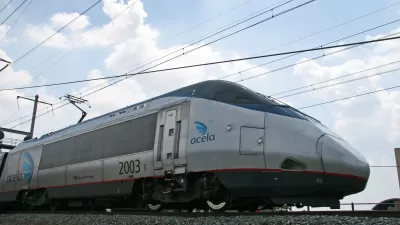The troubled agency has been canceling roughly 100 trains per week.

Writing in Curbed, Nolan Hicks takes a deep dive into New Jersey Transit’s troubled recent history, delving into the reasons why the agency has, in some cases, left passengers stranded in trains for hours — even after raising fares by 15 percent.
According to Hicks, “Two crises are unfolding simultaneously at NJ Transit.” The first, “mostly outside of NJT’s control,” is Amtrak’s failure to modernize the power grid in the Northeast Corridor, much of which NJT shares.
The second crisis is NJ Transit’s lack of resources and subsequent service cuts, with 3,400 trains canceled between January and August of this year. “Even if you subtract those that NJ Transit can pin on Amtrak, the number still stands at more than 2,300, up year-over-year by 800.”
The agency blames service interruptions on an aging fleet, but it does far less maintenance on its trains than comparable systems. Meanwhile, NJT has not added modern innovations such as elevated platforms for faster and easier boarding or electric propulsion systems that have helped systems like New York City’s MTA speed up service and reduce the time trains stop at stations. Multiple governors have promised to fund the system, only to pull back on those goals. According to Hicks, “In 2004, Trenton allocated $618 million for major projects, modernization and improvements at NJ Transit, or approximately $1 billion in today’s money. In 2024, Murphy and lawmakers allocated just $760 million for the fifth year in a row — a shortchange that adds up to $2.4 billion per decade.”
FULL STORY: Why Does NJ Transit Keep Canceling Trains?

Planetizen Federal Action Tracker
A weekly monitor of how Trump’s orders and actions are impacting planners and planning in America.

Congressman Proposes Bill to Rename DC Metro “Trump Train”
The Make Autorail Great Again Act would withhold federal funding to the system until the Washington Metropolitan Area Transit Authority (WMATA), rebrands as the Washington Metropolitan Authority for Greater Access (WMAGA).

The Simple Legislative Tool Transforming Vacant Downtowns
In California, Michigan and Georgia, an easy win is bringing dollars — and delight — back to city centers.

Albuquerque’s Microtransit: A Planner’s Answer to Food Access Gaps
New microtransit vans in Albuquerque aim to close food access gaps by linking low-income areas to grocery stores, cutting travel times by 30 percent and offering planners a scalable model for equity-focused transit.

This City Will Pay You to Meet Your Neighbors
A North Kansas City grant program offers up to $400 for residents to throw neighborhood block parties.

Commentary: Our Silence Will Not Protect Us
Keeping our heads down and our language inoffensive is not the right response to the times we’re in. Solidarity and courage is.
Urban Design for Planners 1: Software Tools
This six-course series explores essential urban design concepts using open source software and equips planners with the tools they need to participate fully in the urban design process.
Planning for Universal Design
Learn the tools for implementing Universal Design in planning regulations.
Smith Gee Studio
City of Charlotte
City of Camden Redevelopment Agency
City of Astoria
Transportation Research & Education Center (TREC) at Portland State University
US High Speed Rail Association
City of Camden Redevelopment Agency
Municipality of Princeton (NJ)





























